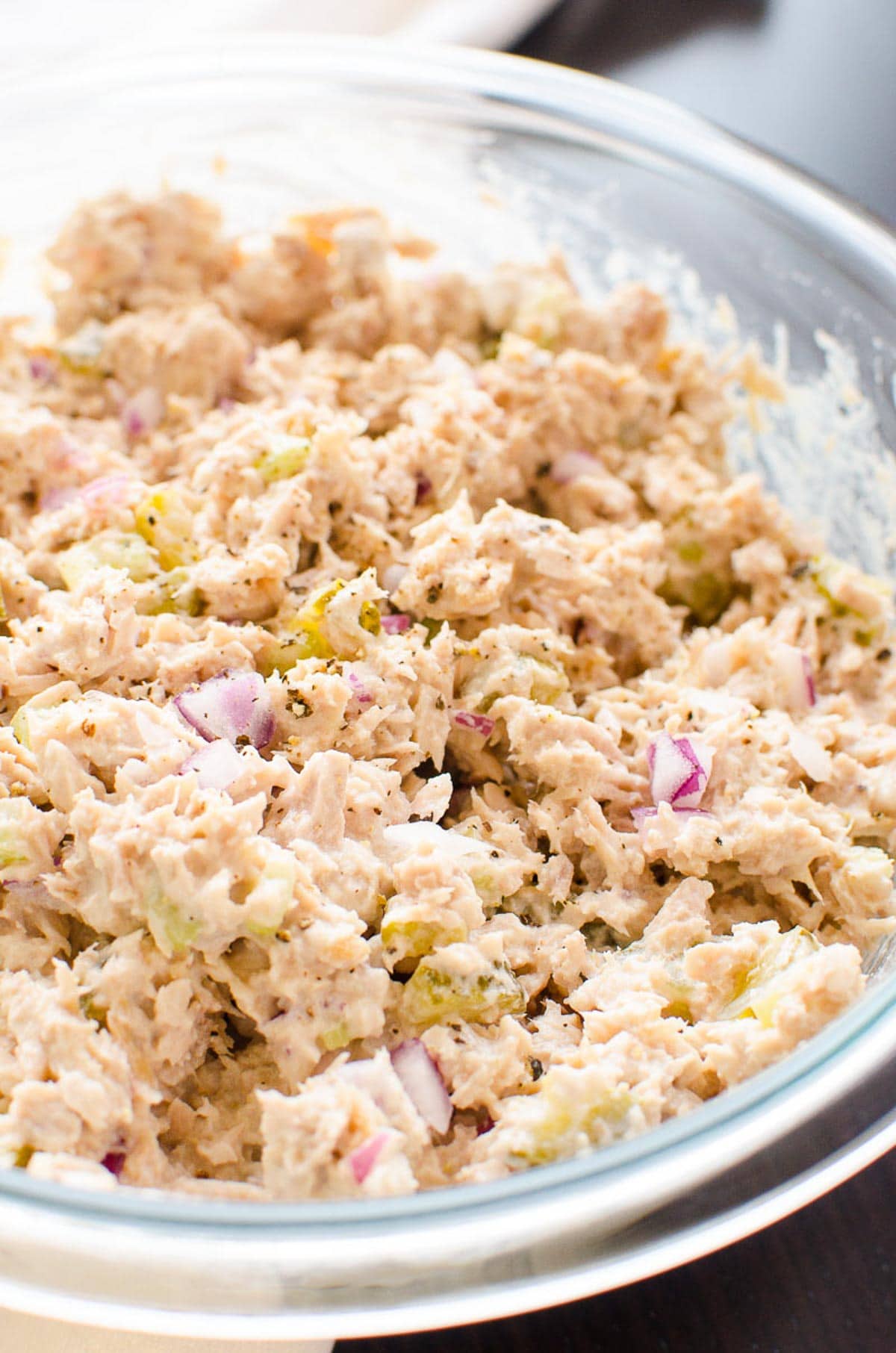Is Canned Tuna Safe? Understanding Mercury And Health Risks
Mercury in Tuna
Types of Tuna
Mercury in Tuna

Tuna is a sort of fish that accommodates mercury, a heavy metallic. Mercury may be harmful to human health, particularly for pregnant ladies and youngsters. The quantity of mercury in tuna varies relying on the sort of tuna. Here is a list of tuna species and their mercury levels:

- Albacore: High in mercury
- Yellowfin: Moderate in mercury
- Skipjack: Low in mercury
Canned tuna is a popular food alternative, however it is essential to pay attention to the mercury content material. Pregnant ladies and children ought to limit their consumption of canned tuna, and select canned tuna created from skipjack tuna each time attainable.
Types of Tuna
- Albacore: Albacore tuna is the biggest of the tuna species. It is high in mercury and must be eaten in moderation.
- Yellowfin: Yellowfin tuna is a medium-sized tuna species. It is reasonable in mercury and could be eaten extra regularly than albacore tuna.
- Skipjack: Skipjack tuna is the smallest of the tuna species. It is low in mercury and may be eaten often.
- Bonito: Bonito is a small, oily fish that is typically utilized in canned tuna. It is low in mercury and may be eaten regularly.
- Bluefin: Bluefin tuna is the costliest kind of tuna. It is high in mercury and should be eaten in moderation.
Mercury Levels
Mercury is a naturally occurring component that could be present in fish, including tuna. Mercury ranges in tuna can differ depending on the species, dimension, and where the fish was caught.
Larger tuna species, corresponding to albacore and bigeye tuna, tend to have greater ranges of mercury than smaller species, corresponding to skipjack and yellowfin tuna. Tuna caught in areas with high levels of industrial pollution can also have higher ranges of mercury.
The Food and Drug Administration (FDA) has set a limit of 1 half per million (ppm) of mercury in canned tuna. This restrict is based on the typical quantity of tuna that people eat and the quantity of mercury that is safe for human consumption.
Pregnant women, women who’re planning to turn out to be pregnant, and young kids ought to restrict their consumption of tuna to no multiple serving per week. This is as a outcome of fetuses and young children are more sensitive to the effects of mercury.
FDA Recommendations
Mercury is a naturally occurring element that could be found in fish and different seafood. The FDA has set a restrict of 0.1 components per million (ppm) of methylmercury in canned tuna. This restrict is predicated on the quantity of mercury that is secure for most individuals to devour.
The FDA recommends that pregnant women and youngsters under the age of 6 ought to eat not extra than 12 ounces of canned tuna per week. Women who usually are not pregnant and children over the age of 6 ought to eat not more than 6 ounces of canned tuna per week.
If you are involved about the quantity of mercury in canned tuna, you possibly can select to eat other forms of fish which are decrease in mercury, similar to salmon, shrimp, or cod.
You can even scale back your exposure to mercury by eating a wide range of fish and seafood. This will assist to ensure that you’re not consuming an excessive amount of mercury from any one supply.
If you could have any questions about the amount of mercury in canned tuna, you must speak to your doctor or a registered dietitian.
Health Risks of Mercury Exposure
Neurological Effects
– Impaired cognitive function, including decreased reminiscence, consideration, and language
– Difficulty with nice motor abilities and coordination
– Tremors
– Muscle weakness
– Numbness or tingling within the extremities
– Changes in vision or hearing
– Sleep disturbances
– Mood changes, such as irritability and depression
– Developmental delays in children
Cardiovascular Effects
Cardiovascular Effects
Exposure to mercury can have opposed results on the cardiovascular system. Mercury has been linked to elevated threat of coronary coronary heart disease, stroke, and arrhythmias. Elevated ranges of mercury within the blood have been associated with increased arterial stiffness, a marker of increased cardiovascular risk.
Mercury’s effects on the center are thought to be primarily due to its capability to trigger oxidative stress and inflammation. Oxidative stress happens when there’s an imbalance between the production of free radicals and the body’s ability to neutralize them. Free radicals are unstable molecules that may harm cells and tissues. Inflammation is a complex biological response to injury or an infection that can also lead to cell harm.
Mercury has been proven to increase the production of free radicals and promote irritation within the heart and blood vessels. This can result in injury to the guts muscle, blood vessels, and nerves that management the heart’s function. Mercury can also intervene with the body’s capacity to regulate blood pressure and coronary heart price.
The cardiovascular effects of mercury exposure are a severe concern, notably for individuals who eat massive amounts of fish or seafood, or who are uncovered to mercury through their occupation or surroundings. Limiting exposure to mercury is necessary for maintaining cardiovascular well being.
Prenatal Exposure
Health Risks of Mercury Exposure
Exposure to mercury, significantly methylmercury, can have adverse effects on human health.
1. Neurotoxicity:
- Damage to the mind and nervous system
- Impaired cognitive operate, reminiscence, and attention
- Autism spectrum disorder
2. Developmental Issues:
- Prenatal publicity can result in start defects and developmental delays
- Cerebral palsy
- Hearing and imaginative and prescient impairment
3. Cardiovascular Effects:
- Increased risk of coronary heart disease
- Elevated blood pressure
- Arrhythmias (irregular heartbeats)
4. Renal Impairment:
- Damage to the kidneys
- Reduced kidney function
- Nephrotic syndrome (excessive protein in urine)
5. Immune System Suppression:
- Weakened immune system
- Increased susceptibility to infections
- Autoimmune disorders
Prenatal Exposure
Prenatal publicity to mercury from maternal consumption can have extreme penalties for fetal development:
1. Neurodevelopmental Disorders:
- Mental retardation
- Autism spectrum disorder
- Attention deficit hyperactivity dysfunction (ADHD)
2. Growth Restrictions:
- Low birth weight
- Stunted growth
- Microcephaly (abnormally small head size)
3. Birth Defects:
- Congenital heart defects
- Cleft lip and palate
- Spina bifida
Benefits of Eating Tuna
Omega-3 Fatty Acids
Tuna is a well-liked fish that is enjoyed by folks everywhere in the world. It is an effective supply of protein, omega-3 fatty acids, and different vitamins. However, there is some concern concerning the security of consuming tuna as a outcome of presence of mercury.
Mercury is a heavy metallic that can be dangerous to human health. It can harm the mind, kidneys, and different organs. Tuna can contain mercury because it is a predator fish that eats other fish that have consumed mercury.
The quantity of mercury in Tuna Salad Egg varies relying on the type of tuna and the place it’s caught. Albacore tuna has the best levels of mercury, adopted by yellowfin tuna and skipjack tuna. Tuna caught within the Pacific Ocean has larger ranges of mercury than tuna caught within the Atlantic Ocean.
The FDA recommends that pregnant girls, women who might become pregnant, and younger kids limit their intake of tuna to not more than 12 ounces per week. The FDA additionally recommends that folks over the age of fifty limit their consumption of tuna to not extra than 6 ounces per week.
If you are concerned in regards to the mercury content of tuna, you probably can choose to eat other types of fish that have lower levels of mercury, corresponding to salmon, pollock, or tilapia.
Omega-3 fatty acids are essential fatty acids that the body can not produce by itself. They are necessary for heart health, mind health, and immune perform.
Tuna is a good source of omega-3 fatty acids. A 3-ounce serving of tuna contains about 1,000 mg of omega-3 fatty acids.
Omega-3 fatty acids have been shown to have a variety of health benefits, together with:
- Reducing the risk of coronary heart disease
- Improving mind health
- Boosting the immune system
- Reducing inflammation
- Fighting cancer
If you might be in search of a healthy way to add omega-3 fatty acids to your diet, tuna is a good alternative. Tuna is a versatile fish that can be cooked in a variety of ways. It may be grilled, baked, fried, or canned.
Protein
Tuna is a popular fish that is usually canned and enjoyed for its taste and nutritional worth. It is a good source of protein, omega-3 fatty acids, and nutritional vitamins and minerals.
Protein
Tuna is an effective supply of protein, which is crucial for building and maintaining muscle mass. One can of tuna (142 grams) contains about 25 grams of protein.
Omega-3 Fatty Acids
Tuna can be an excellent supply of omega-3 fatty acids, which are essential for coronary heart well being. Omega-3s have been shown to minimize back the chance of heart illness, stroke, and other cardiovascular issues.
Vitamins and Minerals
Tuna is an effective supply of a quantity of vitamins and minerals, including:
- Vitamin B12: Vitamin B12 is essential for cell growth and development. It also helps to keep the nervous system healthy.
- Vitamin D: Vitamin D is necessary for bone well being. It additionally helps to manage the immune system.
- Selenium: Selenium is an antioxidant that helps to guard cells from harm.
Overall, tuna is a healthy and nutritious meals that can be loved as a part of a balanced food regimen.
Vitamins and Minerals
Tuna is a well-liked seafood selection that offers numerous dietary advantages. It’s a wealthy source of essential vitamins and minerals, including:
Vitamin D: Tuna is likely certainly one of the few natural meals sources of vitamin D, which is essential for bone and immune system well being.
Omega-3 fatty acids: Tuna is a superb source of omega-3 fatty acids, which have anti-inflammatory properties and will cut back the chance of heart illness and stroke.
Iron: Tuna is an effective supply of iron, which is essential for transporting oxygen throughout the physique.
Niacin: Tuna is an efficient source of niacin, also referred to as vitamin B3, which helps convert meals into power.
Vitamin B12: Tuna is a good source of vitamin B12, which is important for nerve perform and red blood cell production.
Selenium: Tuna is an efficient supply of selenium, an antioxidant that helps shield cells from injury.
Phosphorus: Tuna is an efficient supply of phosphorus, which is essential for bone and teeth health.
Potassium: Tuna is a good supply of potassium, which helps regulate blood stress and fluid steadiness.
Zinc: Tuna is a good supply of zinc, which is important for immune operate and wound healing.
Minimizing Mercury Exposure
Choosing Low-Mercury Tuna
How to Minimize Mercury Exposure
Choose low-mercury fish and seafood:
- Albacore tuna (canned “white” tuna): zero.34 ppm
- Canned light tuna: zero.12 ppm
Limit intake of high-mercury fish:
- Swordfish: 1.02 ppm
- Shark: zero.ninety four ppm
- Tilefish (Gulf of Mexico): zero.eighty five ppm
Pregnant ladies and children should keep away from high-mercury fish altogether.
Cook fish thoroughly to reduce mercury ranges.
Cooking Methods
Minimizing Mercury Exposure: Cooking Methods
Choosing Fish Low in Mercury:
- Select fish low in mercury, such as anchovies, salmon, shrimp, and sardines.
Proper Cooking Methods:
- Grilling: Grilling removes excess fat, which contains a higher concentration of mercury.
- Baking: Baking fish in foil or parchment paper prevents mercury from leaching into the cooking liquid.
- Microwaving: Microwaving fish in water helps retain nutrients and minimize mercury loss.
- Steaming: Steaming preserves nutrients and reduces mercury publicity by minimizing contact with cooking water.
- Stir-frying: Stir-frying in a hot pan permits for quick cooking, preventing mercury from accumulating.
- Remove the skin of fish before eating, as it accommodates larger ranges of mercury.
- Avoid pan-frying or deep-frying fish, as these strategies can increase mercury publicity.
- Trim away the darkish meat of tuna, which has greater mercury ranges than the sunshine meat.
- Limit consumption of huge, predatory fish that accumulate more mercury, similar to shark, swordfish, or marlin.
- Eat quite a lot of seafood to cut back the chance of mercury publicity from anyone supply.
Other Tips:
Frequency of Consumption
Minimizing Mercury Exposure
– Choose lower-mercury seafood choices, such as shrimp, pollock, and salmon.
– Limit consumption of higher-mercury seafood, such as tuna, shark, and swordfish.
– Variety is essential: incorporate a spread of seafood into your diet.
– Pregnant women, nursing moms, and younger kids ought to exercise warning when consuming seafood due to their greater susceptibility.
Frequency of Consumption
– Pregnant girls: No more than 12 ounces of low-mercury seafood per week.
– Children under 6: No more than 1 ounce of low-mercury seafood per week.
– Children 6-12: No greater than 2 ounces of low-mercury seafood per week.

– Adults: No greater than 6 ounces of low-mercury seafood per week; restrict high-mercury seafood to 1 ounce per month.